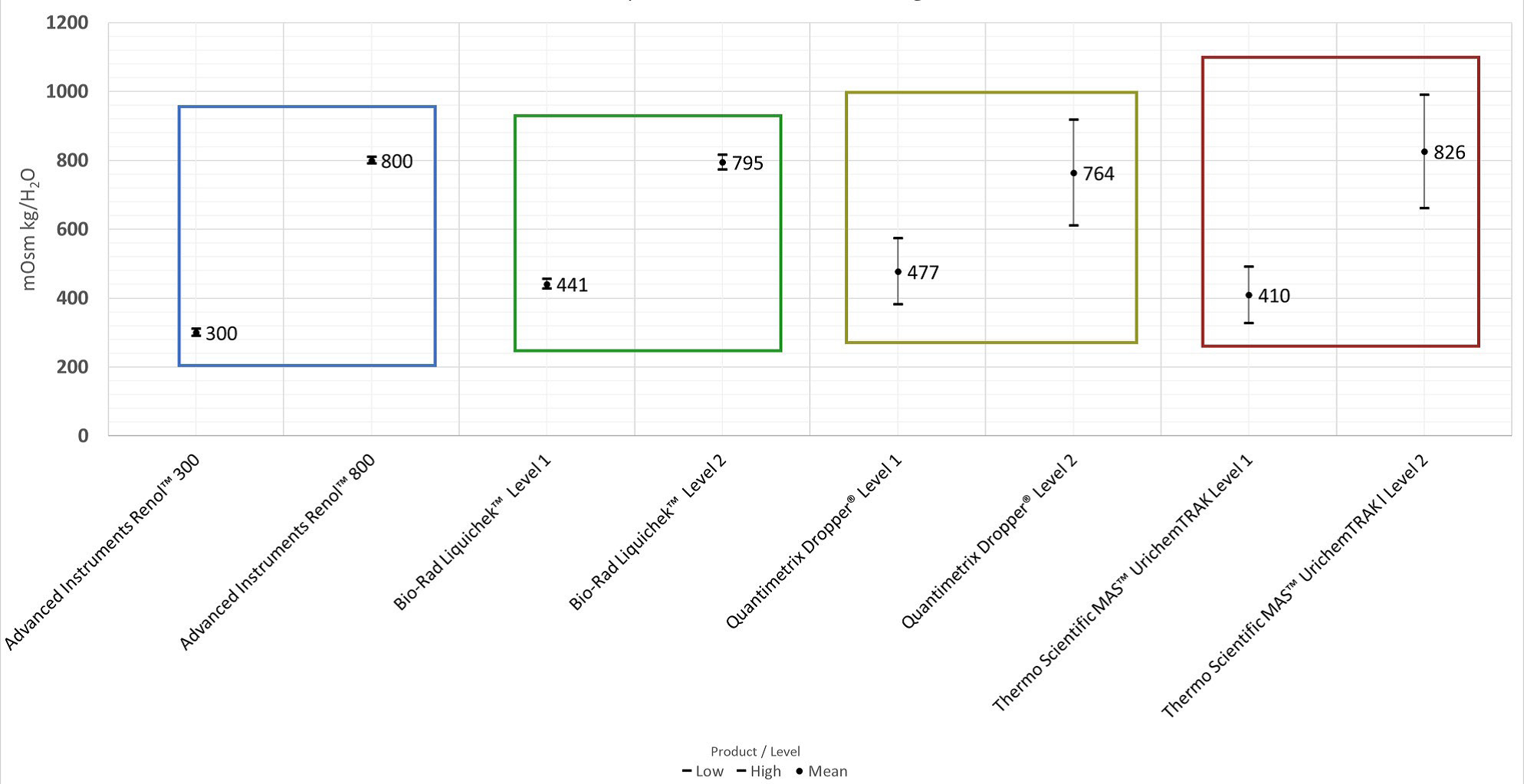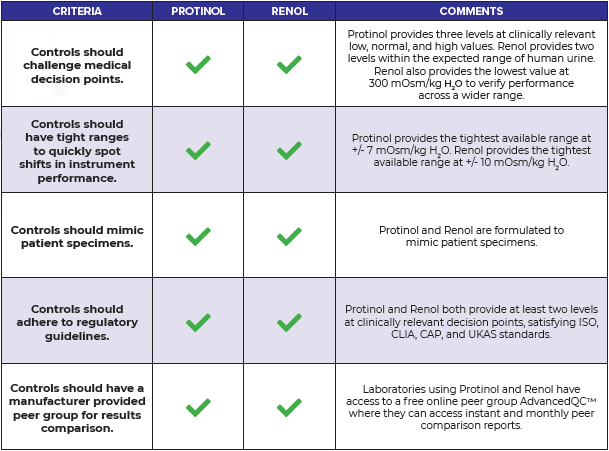
What kind of quality control to use for evaluating the performance of my Osmometer?
| Measuring osmolarity using the freezing point depression technique is an important screening tool for the differential diagnosis of body fluid disorders. |
Advanced Instruments osmometers are trusted to give rapid and accurate measurements of a body fluid’s osmolality.Even a slight shift in the osmolality of a patient sample can be diagnostically significant, making a robust osmometer quality control program critically important.
Features of Quality Controls ideal for clinical osmometers
- Controls should challenge medical decision points. Freezing point osmometers perform measurements over an extremely wide range, so controls should ensure the accuracy of the equipment in the clinically relevant range.
- Controls should have tight ranges to quickly spot shifts in instrument performance. Controls with a reliably tight acceptance range enable the
detection of small shifts in instrument performance. Even a slight shift is patient osmolality values can be diagnostically significant so control ranges should have an accordingly tight acceptance range. - Controls should mimic patient specimens. To provide the best control for osmolality testing, a solutionshould be in a matrix that closely resembles the specimen being tested. The more similar a control is to the patient sample the greater confidence an operator has in the instrument performance with that sample type.
- Controls should support regulatory compliance. The International Standard for Medical Laboratories (ISO15189) specifies that “The laboratory should choose concentrations of control materials, whenever possible, especially at or near clinical decision values, that ensure the validity of the decisions made. This standard is referenced by multiple national bodies such as UKAS. In Spain this standard is not mandatory but every day more and more laboratories use it to certify their quality.
- The controls must have a peer group provided by the manufacturer to compare the results. Peer group programs serve as an external quality control evaluation in which laboratories can compare the results of their control solutions with those of other laboratories to identify trends.

Serum Osmolarity Controls
Following the standards and guidelines outlined above, an ideal serum control solution should mimic patient samples and provide values at medically relevant decision points.
Advanced Instruments comparó las especificaciones de tres soluciones de control de suero: Advanced Instruments Protinol, Bio-Rad Liquid Assayed Multiqual® y Randox Assayed Chemistry Premium Plus.
All three brands of the serum control solutions examined are formulated in a clinically relevant matrix. However, the requirement to provide values at medically relevant decision points is not met in all cases. In healthy patients, the normal value of serum osmolality for adults and the elderly is between 285-295 mOsm/kg H2O. In children, the normal range is 275-295 mOsm/kg H2O. Possible critical serum osmolality values are <265 mOsm/kg H2O or >320 mOsm/kg H2O.6
The following graph compares the mean values and acceptable performance ranges of serum controls from three manufacturers with clinically normal and possibly critical serum results from patients.

Advanced Instruments’ Protinol is the only serum control tested that has control levels at clinically relevant low, normal and high values. The 240 mOsm/kg H2O level is near the low critical value, the 280 mOsm/kg H2O level is within normal, and the 320 mOsm/kg H2O level is near the high critical value.
Multiqual assayed in Bio-Rad liquid has only one level within the clinical range of patient values. Level 1 is near the critical high critical value, with no levels covering the critical low or normal range.
Randox Assayed Chemistry Premium Plus does not offer levels near the low, normal or high values for serum osmolality. All three levels far exceed the high critical value of 320 mOsm/kg H2O.6
To ensure that laboratories confirm the performance of their osmometers at clinically relevant levels, Advanced Instruments recommends Protinol protein-based Osmolarity Controls that can be used in any osmometer.

Urine osmolality values vary greatly depending on many variables such as hydration status. For a healthy adult, urine osmolality values can range from 50 to 1200 mOsm/kg H2O depending on the subject’s fluid intake.
For this work, Advanced Instruments reviewed the product specifications of four urine control solutions: Advanced Instruments Renol, Bio-Rad Liquichek™ Urine Chemistry Control, Quantimetrix Dropper® Urine Chemistry Control, and Thermo Scientific™ MAS™ UrichemTRAK Controls.
Not all urine controls tested provide reliable, tight ranges. Since a small difference in a patient’s urine osmolality value can be diagnostically significant, it is important that controls have a tight acceptability range so that operators can detect small changes in instrument performance. At +/- 10 mOsm/kg H2O, Advanced Instruments Renol offers the tightest range of the urine control solutions tested. Of the controls evaluated, Renol also provides the lowest value at 300 mOsm/kg H2O to verify performance over a wider range.
For these reasons, Renol urine osmolality controls are recommended for quality control of osmometers in the clinical laboratory.

Summary
Advanced Instruments recommends the use of Protinol protein-based controls and Renol urine osmolality controls to confirm the performance of the osmometer before analyzing patient samples. The Protinol and Renol are specifically designed for osmolarity tests and meet or exceed all the requirements of a solid quality control program.
In Tecil we have different models of Osmometers oriented to biotechnology and industry.








